State of Disc Golf 2019 – Average Throwing Distances

During the 2019 State of Disc Golf Survey, we asked players about their average throwing distance on drives. When looking at the overall field of players that responded to the survey, here are the percentages that claimed specific distance abilities:
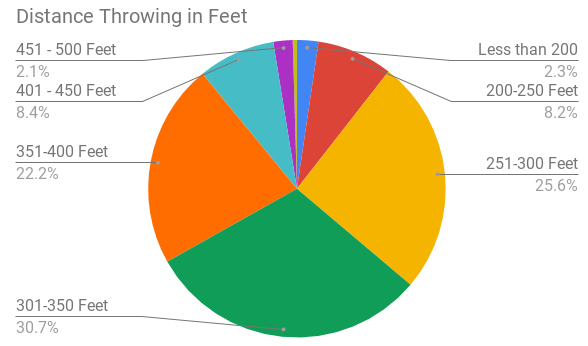
You’ll notice that the largest percentage of overall players claimed a distance between 301 and 350 feet maximum. That distance represents almost 31% of players. The next largest percentage claims a distance between 251 and 300 feet, at almost 27% of those surveyed. Close behind that is the 351 to 400 foot range at 22%.
That means that if you add together those three categories with a distance from 251 – 400 feet, that covers the vast majority of players while much smaller groups claim 400+ feet. Only 2.1% of those surveyed claimed to be able to through 451 to 500 feet and a minor sliver of .5% claimed a distance of over 500 feet.
DISTANCE VS AGE
We thought it would be fun to take a look at the results broken down by age groups. So here is a very chart-heavy report, but we hope that you enjoy seeing how age influences distance. As you scroll through the age breakdowns, you’ll notice that the middle ages have a much higher number of survey participants, but the averages stay pretty close…
AGE 12 – 17
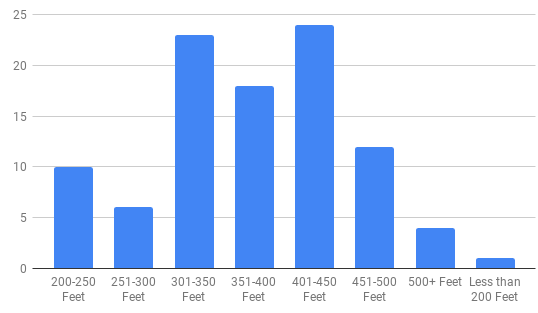
AGE 18 – 21

AGE 22 – 25
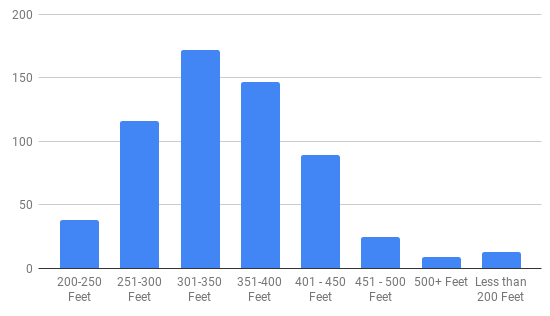
AGE 26 – 29
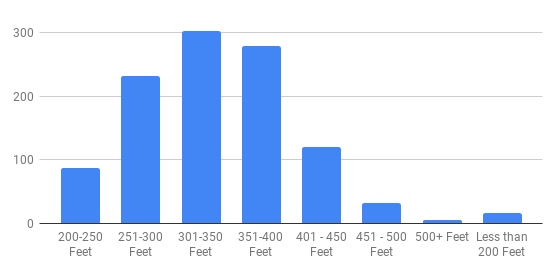
AGE 30 – 35
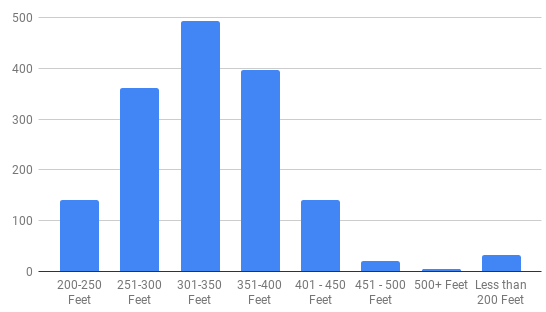
AGE 36 – 40
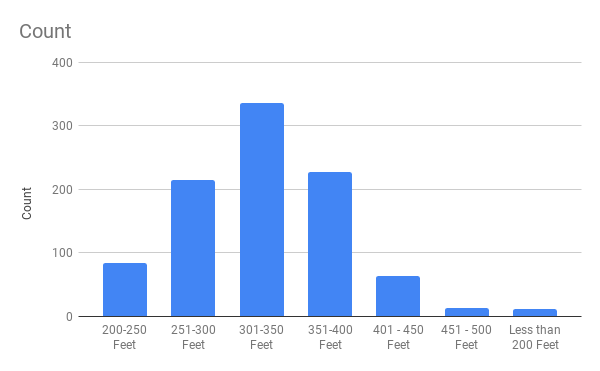
AGE 41 – 50
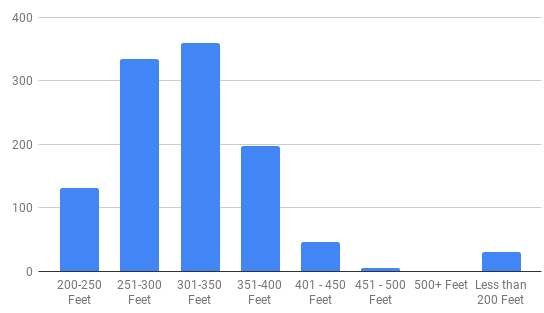
AGE 51 – 60
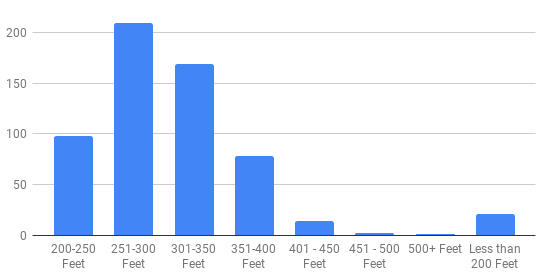
AGE 61 – 70
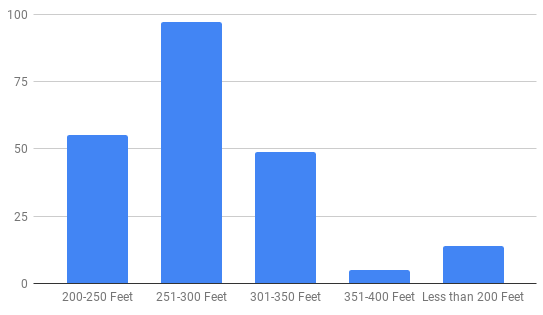
AGE 71 +

Only when you start to hit the charts for 61-70 and the 71+ age groups do the distance abilities begin a dramatic drop-off, landing more of those older players in a range under 300 feet.
DISTANCE VS ELEVATION
Now, for a little something you’ve never considered, we have a breakdown of the claimed distances from survey participants versus the elevation of the states in the USA where those players are from. Did you ever wonder how much elevation figures into distance? While higher elevations often make disc flight paths more overstable (and the reverse for lower elevations), the abilities to throw further seems to favor those who live at higher elevations.
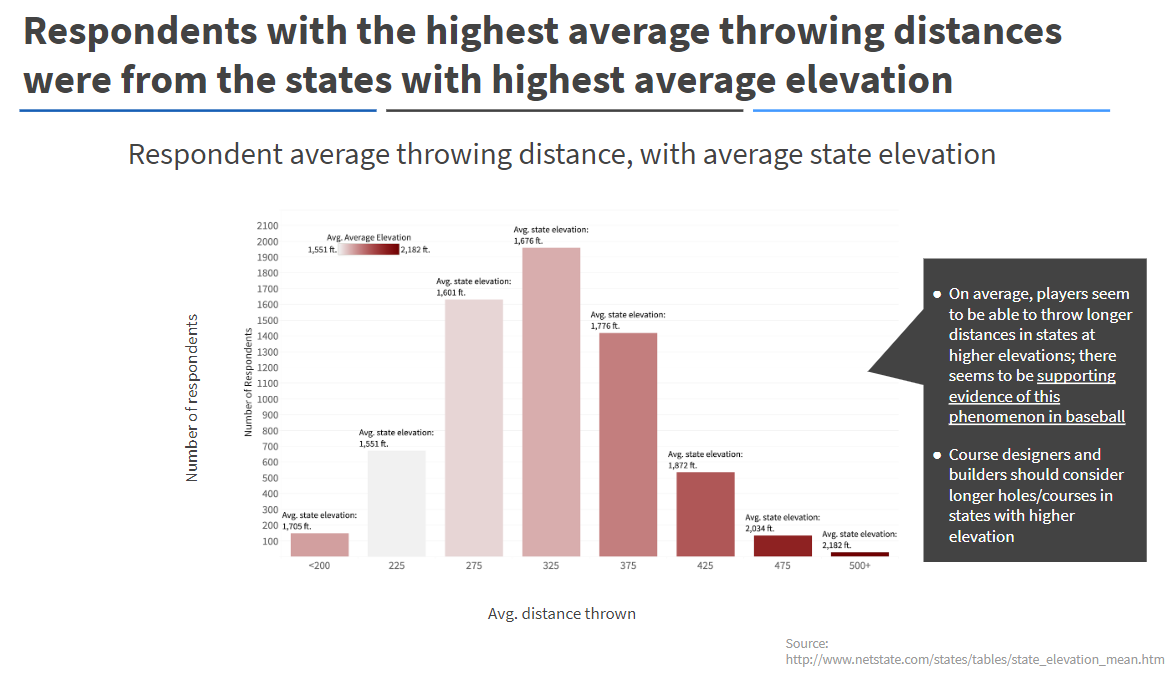
This chart, provided by Lucid Software’s analysis team, can be a little bit hard to decipher, but it basically takes the average elevation of all the survey participants that answered for each distance. You can see that the further the distance (shown at the bottom of each bar) the darker the bar becomes, with the darker bars representing higher elevations. The average elevation is shown above each bar.
The black box feature’s Lucid Software’s bullet points (or take-aways) stating that distance data seems consistent with other sports, like baseball, and that disc golf course designers in higher elevations might consider longer hole distances. Of course, we can take or leave that advice, but the data seems clear regarding distance versus elevation of where players live.
However, here is a thought– it could be that the courses are very different at lower elevations where wooded courses are more predominant. In those lower elevation, wooded courses, players need to play with precision as their focus, rather than distance. After all, if playing in the woods, there is little need for power throws due to low ceilings and obstacles. However, at higher elevations, the trees may be less predominant on courses, making distance more of a factor. You either throw far across open fairways, or bomb high throws over the tops of the few trees on the course.
What do you think is the cause for this distance disparity when it comes to altitude? Leave your thoughts in the comments, and thanks again to all of the thousands of players who participated in the survey.
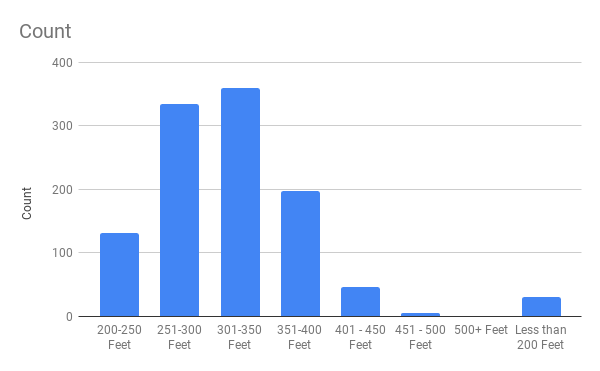

Drop all those distances by at least 50 feet.
99.99% of disc golfers lie about their distance.
As someone who plays at 5000 – 9000 feet in elevation on a regular basis and travels to tournaments at lower elevation. I can say that without a doubt the discs fly farther at lower elevation. I feel like my discs fly about 10-15% farther at sea level then at elevation. While other sports the balls cut through the air, therefore with the thinner are there is less wind resistance. Discs glide on the air, and with less air to glide on, they fall out of the sky quicker.
I haven’t played at lower elevations, but what I have heard is consistent with Ethan. I got a chance to go to the Utah Open last weekend and chat a little bit with Ricky Wysocki. He asked about how I liked his Star Destroyer and I told him I wasn’t able to get enough power on it to make it fly right so I was sticking with the TeeBird3 until I could get my power up. His response was “It is difficult to get the discs to fly as far at high elevations.”
The only comment so far I can agree with is harsh reality. I’m not as cynical as him I would say it is not that they exaggerate the distance they throw. It is they have no concept of distance. Look at the two that claim they throw farther at lower elevation. That is in conflict with science. The air is thinner at higher altitudes and there are more up drafts, which equate to more glide. And another misnomer in the article is lower altitude courses have more trees. What? That is so far from the truth that it is laughable. In the high plains region of the US like Eastern Colorado, Nebraska, and Kansas that may be true but not in the rest of the world.
My pet peeve is people claiming science is on their side when they are just speculating on things they know little about. Science is about looking for answers based on evidence and backing up your claims not claiming to know more than you do.
First of all, I’m not sure if I throw farther at altitude than sea level. All I know is the discs fly more overstable and it’s harder to get them to hold anheizer angles for as long. But… Thinner air = more glide? Lol that’s nonsense. Here in Colorado discs fly with very little glide compared to lower elevations. Air is what makes glide a thing!!! And up drafts? What in the world are you talking about lmao. Also you used misnomer wrong. That’s not what it means. Don’t claim “science”
when you don’t know what you’re talking about it makes you look foolish.
Can I get some feedback on disc’s to purchase for a newby, ex-baseball player. To point me in the right direction, so many choices out there. Many thanks to any help. cooper
It is really hard to suggest a disc for you without watching you throw a little. Another thing I’ve noticed when people ask this kind of question is that you generally get every disc known to man mentioned. My suggestion is something that Ricky Wysocki told me when I played with him at my home course. He said to go with neutral or slightly understandable putters or Mids so that you can learn to throw with good form and control your angles better. That being said, I am partial to Trilogy discs. The EMac Truth is a really good mid. The warden is a really good neutral putter for throwing. Pure’s are really good throwing putters with lots of glide. The great thing about trilogy discs is the buy back option. If you buy a trilogy disc from a buy-back retailer you have 14 days to throw it and if you don’t like it you can take it back and either get a different trilogy disc or a disc from any other retailer. If you really want to try a driver I would suggest something like an Escape, Maverick, or Explorer.
I agree with Jason’s advice. My son has a truth and he likes it. I am thinking of buying a couple for my son who is a missionary because the mold is a great mold to throw and the name is an awesome name for a missionary. The Pure also fits the name criteria now that I think about it, maybe he needs on of those too… 🙂 In the Innova line it would be a Mako3 or Nova that would be the does what you tell them to do them discs. If you see them on hyzer on anhyzer you know it was you that did it. In Infinte discs the Anubis is a laser. In Discraft the buzz…
My advise is to start throwing mid range and putters with weights between 155-165. This will teach you how to throw. Get Judge or Warden(putter and approach), a Roc or Buzz( mid range)and a leopard (fairway). Don’t over throw learn to throw firm smooth and controlled. If after awhile you find these disc eventually flip over for you . Go to higher weights and speeds. Also recommend to start practicing backhands and forehands right away. Super helpful, you’ll find one is easier but having both us a huge asset.
Here’s the deal with altitude. The higher the density of the air the more lift you get. The lower the temperature of the air the more lift you get. Glide range equals lift divided by drag. At high altitude the temperature is lower creating more glide. The air density does decrease at high altitude but not enough to effect lift on the earth’s surface. And not enough to overcome lower temperatures and updrafts that create more glide.. If you were throwing a disc at 6 miles up in the air it might give you less glide. But the ratio on earth at altitude levels where you could breathe the air the air density does not change as drastically as air temperature. Technically you should be able to throw the same distance at sea level as at 3000 feet above sea level. But updraft comes into effect at higher elevation. Now in another blog Christian Dietrich says he steps down to a Sidewinder at higher elevation to get same distance as he does at lower elevations with a Destroyer. Problem I have with his comments is that the high elevation courses he plays on in Montana the hole lengths are not measured properly. I’ve had this argument with these so called disc golfers in Montana. I am a professional that does mapping and I have measured many of the holes in Montana and have found them to be way out of whack. For instance they will say a hole is 420 feet long to cater to the drug crowd when the hole is actually 446 feet. So I would have to personnally observe his throwing at low altitude as I have observed at high altitude. It doesn’t matter he throws far at any altitude. In my earlier comment I said air is thinner at high altitude to create more glide when I meant air temperature is lower creating more glide. (Typing faster than I could think.)
Temperature does not affect things more than air density that’s ridiculous. I play at 85 degrees and below freezing at the same elevation and it does not noricabley affect glide on discs. But you can play in Denver and go into the mountains and play and see for yourself how the elevation changes the discs flight with very little variation in temperature. I don’t personally believe it affects distance mich either way. But it affects stability greatly which is the affect people notice when they play at different elevations. It’s harder to get the same discs to go as far at elevation because they become too overstable. You just have to switch to something slower or more understable like Christian said. You can also notice the glide difference just in putting.
Now i just finished talking to a pilot. You also have to consider barometric pressure (humidity) when it comes to lift. So at high altitude a bullet and a football will travel farther than at sea level. But a wing (which a disc is) will technically glide farther at sea level because of barometric pressure (also dew point is a factor of barometric pressure). The denser the air the more glide, but air density also has to do with the dew point which is a factor of humidity and temperature. Lower temperature the denser the air. Lower temperatures are associated with high altitude. Lower temperature the greater the lift which makes for greater glide. The question comes down to are you at sea level next to the ocean or sea level in the middle of a desert? Are you at high altitude in a rain forest or in Eastern Colorado? Trade offs exist which is why the argument started from personal observations.
I’m no longer a pilot, but I did graduate with honors from Spartan School of Aeronautics. There’s four factors of flight: thrust, drag, weight, and lift. Cold dry air at sea level has the highest density, which results in greater lift. However, these conditions also result in greater drag. The difference between an airplane and a disc is that a disc doesn’t have continual thrust to overcome the drag. All the thrust is expended at the time the disc leaves your hand. Drag begins to take over at that point. A disc thrown at altitude will have far less drag to overcome. This decrease in drag more than compensates for the corresponding decrease in lift, which results in increased distance. If someone is struggling to throw further at altitude, they should start throwing more understable lightweight discs.
Lmao I filled this out saying I throw 350-400 ft but with some form corrections I now throw in the 400-450 range
actual distance 325.
I live in boise, ID and am 33. We have both, wooded shots and open shots. Ive never struggled reaching 500+ ‘ RHFH, unless its below 40°F. Once its below that temp ill be between 430 and 450 max. Never have played at sea level, but will find out how the discs fly while near La Mirada, end of this month. Really curious now to see what the truth really is..
Highet elevations mean less gravity. Nfl kickers in denver kick farther. Also, in humid areas like florida the humidity slows disc down as friction. So one can throw farther is Las Vegas. Also, wind is low in florida due to trees but in Nevada there are no trees. Very windy.
have a 400 foot long, open field, very flat hole that I can see from my back yard.
see hundreds of players play that hole each year. might see 2 or 3 players get that far. out of at least 500.
I’m just getting into the sport, so not sure on average yet. Was just trying to find out what sort of distance most average players throw.
As a comment, I wouldn’t have expected distances to drop off as fast as they seem to even up to about age 40 or so. Maybe after that power and flexibility would drop off a bit and limit distance. I do wonder if the older you get the more realistic people are about their average distance!
Also I expect some people are a bit hazy on the concept of an average – possibly not considering drives as normal where they just don’t get it right at all and it goes less that what they might normally throw.